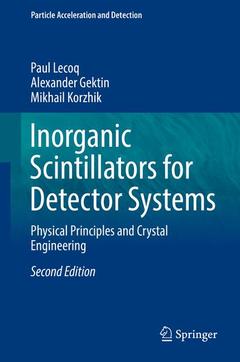Inorganic Scintillators for Detector Systems (2nd Ed., Softcover reprint of the original 2nd ed. 2017) Physical Principles and Crystal Engineering Particle Acceleration and Detection Series
Auteurs : Lecoq Paul, Gektin Alexander, Korzhik Mikhail

This second edition features new chapters highlighting advances in our understanding of the behavior and properties of scintillators, and the discovery of new families of materials with light yield and excellent energy resolution very close to the theoretical limit. The book focuses on the discovery of next-generation scintillation materials and on a deeper understanding of fundamental processes.
Such novel materials with high light yield as well as significant advances in crystal engineering offer exciting new perspectives. Most promising is the application of scintillators for precise time tagging of events, at the level of 100 ps or higher, heralding a new era in medical applications and particle physics.
Since the discovery of the Higgs Boson with a clear signature in the lead tungstate scintillating blocks of the CMS Electromagnetic Calorimeter detector, the current trend in particle physics is toward very high luminosity colliders, in which timing performance will ultimately be essential to mitigating pile-up problems. New and extremely fast light production mechanisms based on Hot-Intraband-Luminescence as well as quantum confinement are exploited for this purpose.
Breakthroughs such as crystal engineering by means of co-doping procedures and selection of cations with small nuclear fragmentation cross-sections will also pave the way for the development of more advanced and radiation-hard materials. Similar innovations are expected in medical imaging, nuclear physics ecology, homeland security, space instrumentation and industrial applications. This second edition also reviews modern trends in our understanding and the engineering of scintillation materials. Readers will find new and updated references and information, as well as new concepts and inspirations to implement in their own research and engineering endeavors.
Paul Rene Michel Lecoq received his diploma as Engineer in Physics Instrumentation at the Ecole Polytechnique de Grenoble in 1972, under the leadership of Nobel Laureate Louis Neel. After two years of work at the Nuclear Physics laboratory of the University of Montreal, Canada, he got his PhD in Nuclear Physics in 1974. Since then he has been working at CERN in 5 major international experiments on particle physics, one of them led by Nobel Laureates Samuel Ting. His action on detector instrumentation, and particularly on heavy inorganic scintillator materials has received a strong support from Nobel Laureates Carlo Rubbia and Georges Charpak. He has been the technical coordinator of the electromagnetic calorimeter of the CMS experiment at CERN, which played an important role in the discovery of the Higgs boson. Member of a number of advisory committees and of international Societies, he is the promoter since 2002 of the CERIMED.NET initiative (European Center for Research in MedicalImaging) for networking physics and medicine in the field of medical imaging. He has been awarded an ERC advanced grant in 2013 by the European Research Council. He has been elected in 2008 member of the European Academy of Sciences and elevated in 2015 to the IEEE fellow grade.
Alexander Gektin received his diploma after graduating at the Physical faculty of Kharkov university. His PhD thesis (1981) was devoted to defects study in halide crystals. He got his DrSci degree in 1990 (Riga, Latvia) when he investigated the influence of high irradiation doses to crystals. During the last two decades he took part as a renowned scintillation material scientist to several international projects like BELLE, BaBar, PiBeta, CMS in high energy physics, GLAST and AGILLE in astrophysics. At the same time he has led several developments for medical imaging (large area SPECT scintillator) and security systems (600 mm long position sensitive detectors).The major part of these technology develop
Date de parution : 12-2016
Ouvrage de 408 p.
15.5x23.5 cm
Date de parution : 07-2018
Ouvrage de 408 p.
15.5x23.5 cm



